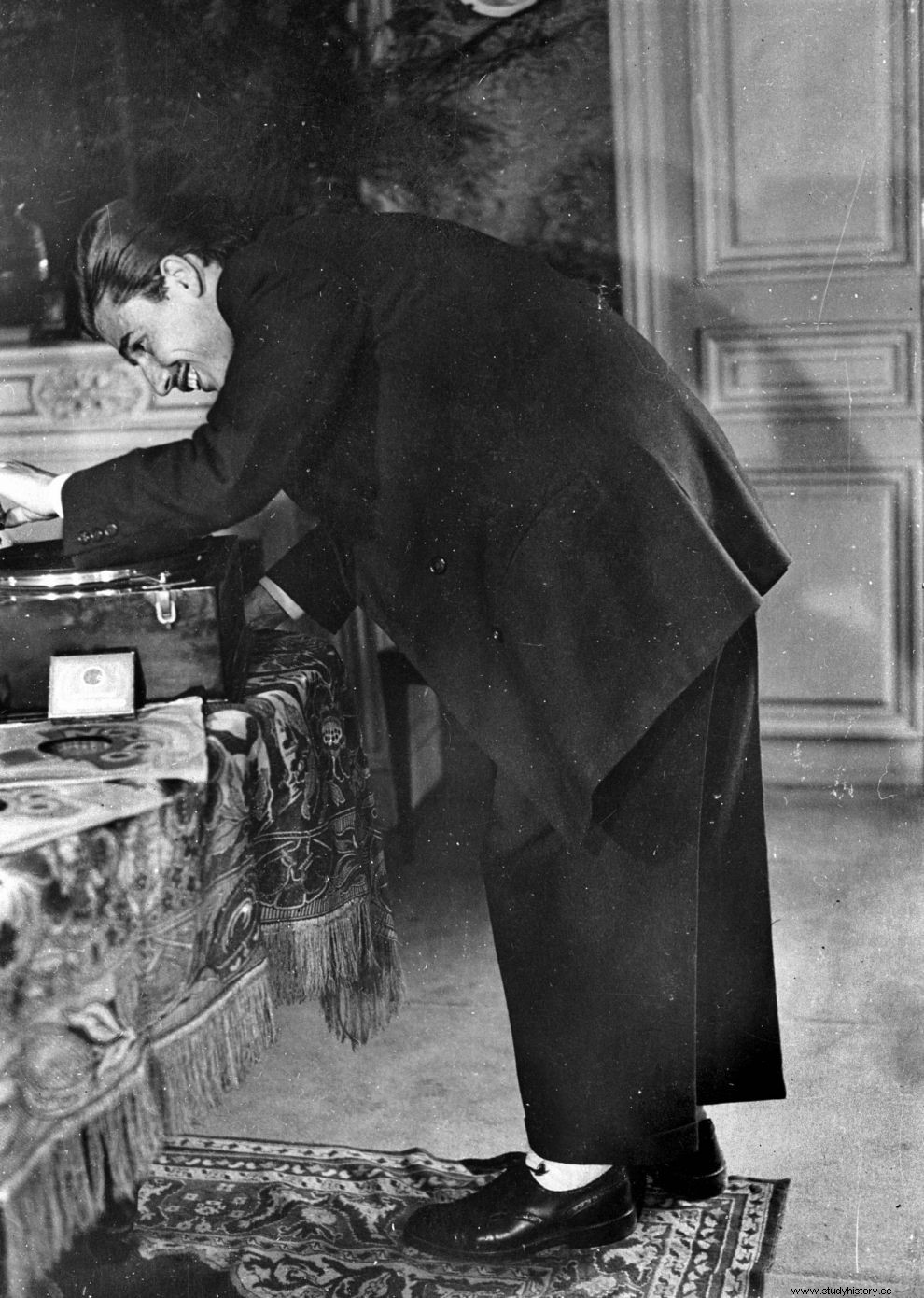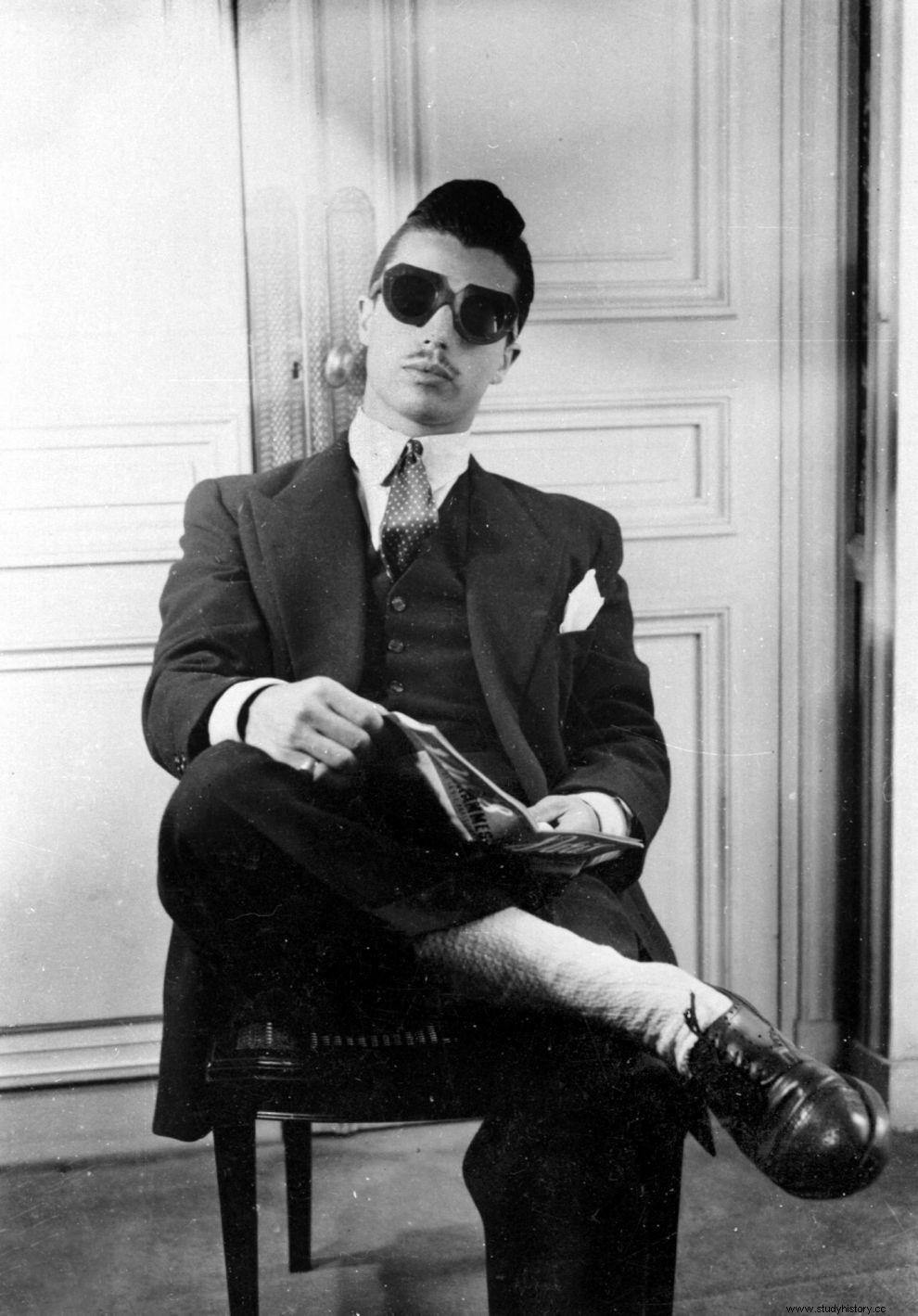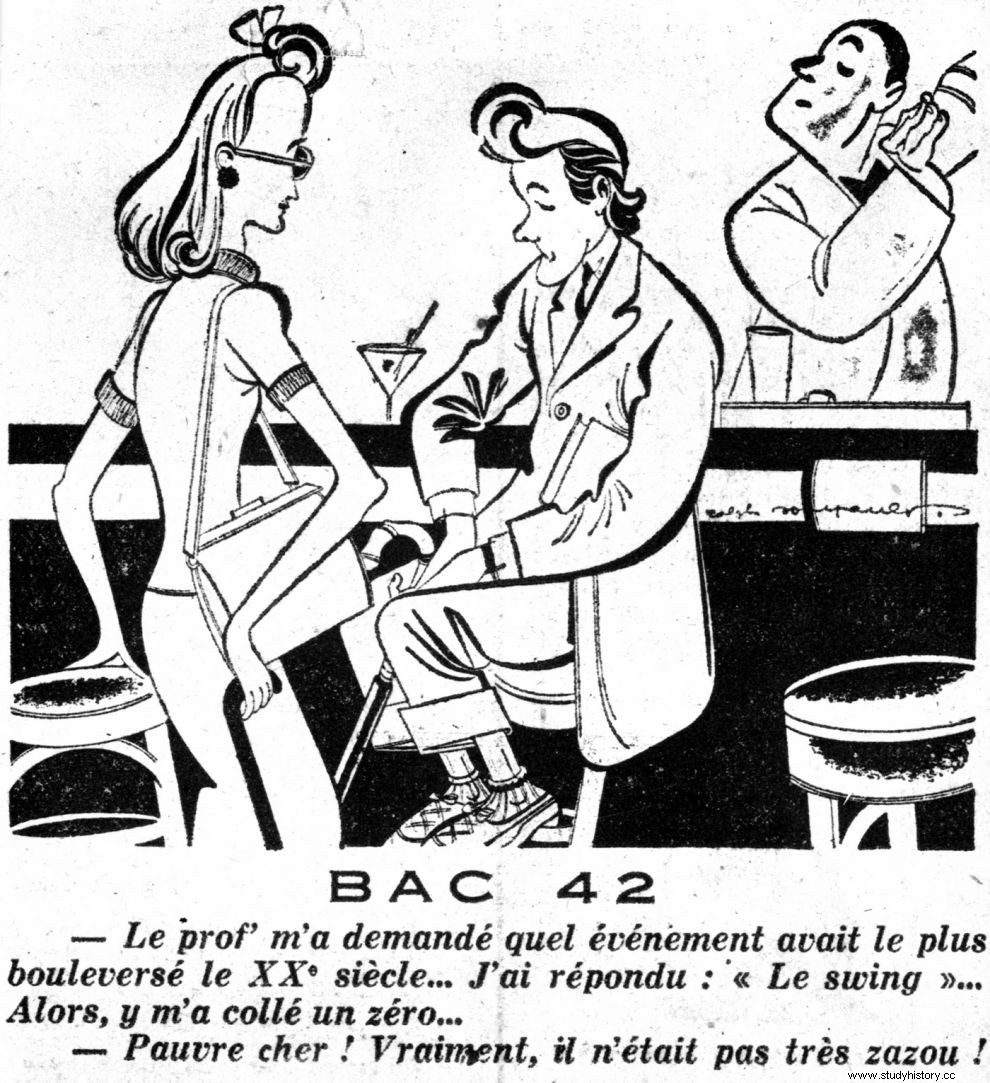They did not go down in history for their political pamphlets, nor for their armed resistance in the Parisian streets. The Zazou's only "weapons" were their dress, their speeches and their general anti-Nazi attitude.
Although they did not raise their pistols against the enemy (at least in the early years of the Nazi invasion) the members of the Parisian art group in Nazi-occupied Paris were targeted by the fascists. In every period of history, fashion finds a way to disturb, let alone in the midst of a totalitarian regime like the one set up by Hitler. Zazou's visual identity was enough to summarily sideline them.
As for their constitution, their main characteristic was a passive indifference to the system of the time, and an unwillingness to follow the conventions of the past. They were inspired by the French jazz scene of the 1920s, and ultimately the consistency of their stance in the midst of World War II was expressed as a non-violent cultural resistance.
During the Nazi Occupation of 1940, France was cut in two by the Nazis who established an ultra-conservative rule, flanked by an authoritarian and racist puppet government, called upon to administer the occupied territories. In the midst of this climate, Zazou organized around their love of jazz, without acquiring characteristics of a movement, or an organized group with grassroots members and actions.
The Nazis had banned jazz music, which was characterized as a "mechanism of cultural degeneration". A decade earlier, Paris was dominated by the jazz "invasion" from the USA, naturally having strong African-American elements, reviving a France tired of the previous war conflicts.
Many Swing clubs appeared in Paris, especially in Montmartre. It was also where Zazou was born, named after Camp Calloway and his track Zah Zuh Zahby. It was the interwar years when many African-American artists found a home in free Paris, immigrating to the city, enriching the musical landscape and encouraging homegrown talents like Django Reinhardt to embrace swinging jazz.
Now, here's a very entrancing phrase,
It will put you in a daze,
To me it doesn't mean a thing,
But it's got a very peculiar swing!
Zaz-zuh-zaz-zuh-zaz,
Zaz-zuh-zaz-zuh-zay,
Zaz-zuh-zaz-zuh-zaz,
Zaz-zuh-zaz-zuh-zay!
In 1944, Andrex made a direct reference to Zazou, in his title track.
"Up until now a man could be black or white or yellow or red and that's all / But a new race was born, it's the Zazous. / A false collar up to the jaws with a jacket down to the knees, / Hair down the back, / That's the Zazou, that's the Zazou. / There are Zazous in my neighborhood / I'm half there myself / And one of these days, / You'll all be Zazous like them, / Because the Zazou is contagious".
Fashion Rebels
Cab Calloway's appearance and aesthetic, dress and movements became a point of reference for Zazou, while they themselves showed a particular preference for Manouche Jazz, or Gypsy Swing Jazz. Gradually, jazz created from the 30s an awareness of cultural diversity, experimentation and freedom of expression, while bringing something fresh and modern to the rhythms of the time. The incorporation of these characteristics made the Zazou look like a red flag to the occupying Germans and also to the Vichy Government, the pro-German government formed by World War I French field marshal Philippe Petain in the free part of France south of the Loire. , after the German invasion and capitulation during World War II.

By most accounts, the swing kids of Paris were active from 1938 to 1942. Amid German occupation, these young people created a revolutionary expression through fashion, and made sure the authorities took notice, showing off their style in neighborhoods and places frequented by the Nazis. They circulated in cafes such as Pam Pam on the Champs-Elysées and Boul'Mich in the Latin Quarter, not hiding in illegal bars. At the same time, the Zazous formed their own slang that adopted English words and phrases, especially the word "swing" which became, according to Jean-Claude Loiseau, "un mot passe-partout" (a password for all needs).
Zazou men wore oversized jackets, light-colored fancy jackets adorned with large pockets, and were characterized by thin, narrow ties. Their trousers were short, revealing colorful socks and thick-soled suede shoes. Hair was often long and unkempt, possibly in protest of a law requiring all men to be short-cropped. Umbrellas were an essential accessory, a reference to the English and "Le Style Anglais". They even used to have a Clark Gable mustache.

British historian W.D. Hall aptly described the Zazou women. "They preferred tight sweaters with short skirts and platform shoes. They wore dark glasses with large lenses, painted brightly and also dyed their hair in different shades. They even chose not to wear hats in public, precisely for this reason." "Bouffant hair" was a feature of theirs, accompanied by bright red lipstick, which directly referred to the Hollywood stars of the 1930s. The above went against the regime of extreme maintenance.
Also, they were known for the cocktails they made themselves, while claiming that their clothes were improvised, designed and sewn by themselves.
Christian Dior himself would later give his own critique of the Zazou look in his 1957 autobiography, Dior by Dior. "The hats were too big, the skirts too short, the jackets too long, the shoes too heavy." Dior served as an officer in the French army, but then found a job in a Paris house, dressing Nazi women as well as wealthy French bourgeois. His younger sister, Catherine, had joined the French Resistance. "I have no doubt that this style, Zazou, came from the desire of these children to defy the occupying forces. Their clothes were paraded around Paris as a revolutionary flag. As a fashion, however, I found it repulsive," he would later write. the Dior.
Simone de Beauvoir describes their style as an emphatic reaction to the austerity imposed by the dutiful administration, presenting their own version of mode à la Oxford.
"Scalp the Zazous!"
In 1940, the French press was flooded with articles against the Zazou youth, peddled by the Vichy government. Gradually, through these articles Zazou's popularity increased, many young people began to go to their haunts and adopt their style, and as a result, came the ultimate crackdown.
For example, the pro-German La Gerbe wrote:
"We have great difficulty in eradicating the poison of Americanism. It has entered our customs, it has permeated our culture. We must make every effort against these transgressions of taste and manners. The decay of critical faculties, the nonsense of jazz and swing, the corruption of our youth by American cocktail parties".

The "Scalp the Zazous!" became the cry of the Jeunesse Populaire Française, a fascist youth organization, and it soon became a practice. Arrests began to multiply, while those arrested were cut and sent to "workshops" of the Vichy government, for their "reintegration".
A provocative and perhaps most unpopular feature of the Zazou was their attempt to show that they had their own money, against the strict austerity policy of the occupying forces and their collaborators. With the same methodology followed for the arrests of the Jews, the Nazis rounded up the Zazou and subjected them to forced labor. The most courageous of the Zazou also nailed the Star of David, which read "Zazu" or "Swing". Many were sent to German concentration camps, accused of sedition and homosexuality, their fate unknown. In solidarity with the male prisoners, the Zazou women began to paint their faces black, naturally referencing the jazzmen of the American South. At the same time, most of the members of Zazou who escaped the persecution went underground, frequenting underground makeshift bars and clubs, while they also went to the guerilla. In the Latin Sector, the Zazous now met in the underground clubs Dupont-Latin or Capoulade.
As Cecile Paul writes, the liberation of Paris in 1944 by the Allied forces saw many Zazou now join the war lines to rid the city of the Nazi occupiers. However, their contribution was not accepted by the mainstream political movements, in contrast to the action of groups with class characteristics, such as the Edelweiss Pirates. All in all, dandyism and hedonism, their aversion to work and their love of "degenerate" jazz, gave them some elements that could form a kind of movement, if they lasted over time.
According to Paul McQueen, Zazou were the forerunners of the 70s subculture and the beginnings of clubbing. Their eccentric stylistic code is considered a forerunner of the style of teddy boys and rockabilly.
It would not be an exaggeration to say that the beginning of punk can be traced to Zazou in terms of radical expression, or even stylistic trends such as glam rock. Their penchant for dancing in the underground hangouts of Paris gave Eddie Barclay the idea to open the first discotheque after the war in 1947. Even today, young Parisians are used to incorporating English words into their slang to express their opposition to the system, and despite the annoyance of the French Academy.
Instead of an epilogue:In 1986, the Pet Shop Boys wrote "In the night" for Zazou, as the b-side to the single, Opportunities (Let's Make Lots Of Money). And we close like this.
Zazou, what you gonna do?
There's a lot of people gunning for you
Zazou, comment allez-vous?
A knock on the door in the night
That Zazou he doesn't care
Dark glasses, long hair
Takes his time, sneers at men
Some ugly people want revenge
Zazou, comment allez-vous?
A knock on the door in the night
In the night
